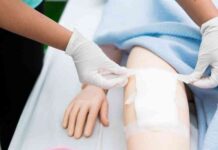Erfurt (dpa/th) – New infection rules will come into force in Thuringia from Saturday. After that, the mask requirement in local public transport continues, as the Ministry of Health announced on Thursday. However, an FFP2 mask does not necessarily have to be worn, a medical mask is also sufficient. There will be no extension of the mask requirement to sales and event rooms or to gastronomy. The regulation is valid until November 12th.
The Free State also uses the possibility for exceptions given by the federal government for the obligation to test. In this way, vaccinated and recovered people in hospitals and nursing homes and the employees there remain exempt from the test requirement. This also applies to people who only stay in these facilities for a very short time.
Employees in hospitals and nursing homes who are neither vaccinated nor recovered can also meet their obligation to test three times a week through self-tests. There is no obligation to supervise.
With the new regulation, the Free State is adapting the state rules to the amended Federal Infection Protection Act, which generally allows for stricter requirements for masks and tests.
“As far as the infection situation, the load data of the health system and the revised Infection Protection Act allow, we want to continue the previous protective measures in Thuringia,” said Health Minister Heike Werner (left). The number of cases and hospitalization rates has been increasing again since mid-September. In a national comparison, however, Thuringia is still one of the states with the lowest values.
The Robert Koch Institute (RKI) gave the number of new infections per 100,000 inhabitants within seven days for Thuringia as 373.4. In the previous week, the value was still 187.5. Nationwide, the seven-day incidence rose from 281.4 to 409.9 in a weekly comparison.
The district of Schmalkalden-Meiningen reported the highest incidence in Thuringia (513.8) – the lowest in the city of Weimar (171.9). However, experts have been assuming for some time that the information does not fully reflect the infection situation because not all infected people have a PCR test done and only those are counted in the statistics.







